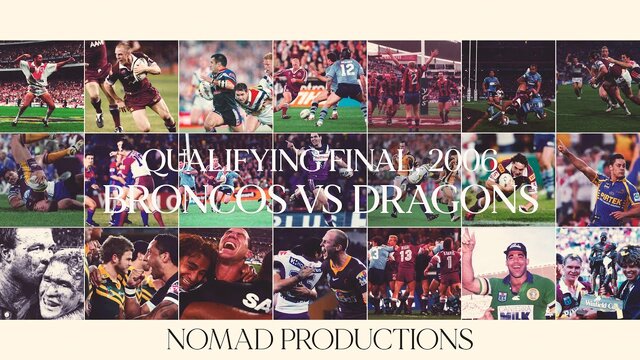- Jan 25, 2013
- 25,705
- 30,048
Traditionally, the #7 is the controlling half and the #6 is the running half.
It's why in Union they call the equivalent a fly-half. They still take on kicking, passing, playmaking duties, but they normally have a better running game than the 7.
Think of the spine going from hooker to halfback to five-eighth to fullback. That's how the passing and organising goes - hooker either passes straight to the forwards or to the halfback and on to the forwards, in order to move the team around and point the attack where it needs to go. Mainly in terms of moving the opposition forwards around to wear certain players out or over-work a potential weakness to draw others in and make them short on the edges or out wide.
Once weaknesses have been exploited or created, the five-eighth comes more in to play to prove in the gaps, either drawing in more defenders (and then passing wider as they'll have more space), or cutting through themselves. And then the fullback comes in to play as an extra number, or similar to the 6 in terms of punching through or drawing defence and getting the ball outside.
That's why a #7 can normally be more of a plodder (Peter Wallace, Chad Townsend) but need better game awareness and coolness under pressure as they need to move our players around and by extension the opposition players around. The #6 traditionally handles the ball less because they are better off waiting until the halfback has made the space and pouncing. Hence why they're normally better runners and are share some attributes with fullbacks, eg, Lockyer, Milford, etc.
The better combinations take the heat off each other. Cronk makes his halves partner look better because he, alongside Smith, moves the players around and causes weaknesses or fatigue in the opposition defence. Allowing the #6 more space. Similarly, if the 6 has a threatening running game and they get involved more they put the defensive line on alert, meaning they have to move around, commit numbers, wear out more so that the halfback has better targets to run their forwards at and potentially isolate and exploit.
Thurston is genuinely a 6 and a 7 as he has great game awareness, vision, knows where to point the attack but also has a deadly running game. Morgan is effective beside him because the threat of Thurston gives him more space, the opposition forwards have been worked over more, and Morgan has both a threatening running game but good enough long & short passing and kicking game to be a playmaker. But without the world's best in Thurston doing his work, he doesn't have the talent to exploit the limited opportunities.
For Milford to succeed as a halfback, he needs to be switched on 100% of the time, he needs to learn the subtleties of directing the point of attack not just to make metres but as the opposition fatigues and presents attacking opportunities, and have a cool head under pressure to make the right decisions both in running, passing, and kicking, depending on the status of the opposition defence.
It's why in Union they call the equivalent a fly-half. They still take on kicking, passing, playmaking duties, but they normally have a better running game than the 7.
Think of the spine going from hooker to halfback to five-eighth to fullback. That's how the passing and organising goes - hooker either passes straight to the forwards or to the halfback and on to the forwards, in order to move the team around and point the attack where it needs to go. Mainly in terms of moving the opposition forwards around to wear certain players out or over-work a potential weakness to draw others in and make them short on the edges or out wide.
Once weaknesses have been exploited or created, the five-eighth comes more in to play to prove in the gaps, either drawing in more defenders (and then passing wider as they'll have more space), or cutting through themselves. And then the fullback comes in to play as an extra number, or similar to the 6 in terms of punching through or drawing defence and getting the ball outside.
That's why a #7 can normally be more of a plodder (Peter Wallace, Chad Townsend) but need better game awareness and coolness under pressure as they need to move our players around and by extension the opposition players around. The #6 traditionally handles the ball less because they are better off waiting until the halfback has made the space and pouncing. Hence why they're normally better runners and are share some attributes with fullbacks, eg, Lockyer, Milford, etc.
The better combinations take the heat off each other. Cronk makes his halves partner look better because he, alongside Smith, moves the players around and causes weaknesses or fatigue in the opposition defence. Allowing the #6 more space. Similarly, if the 6 has a threatening running game and they get involved more they put the defensive line on alert, meaning they have to move around, commit numbers, wear out more so that the halfback has better targets to run their forwards at and potentially isolate and exploit.
Thurston is genuinely a 6 and a 7 as he has great game awareness, vision, knows where to point the attack but also has a deadly running game. Morgan is effective beside him because the threat of Thurston gives him more space, the opposition forwards have been worked over more, and Morgan has both a threatening running game but good enough long & short passing and kicking game to be a playmaker. But without the world's best in Thurston doing his work, he doesn't have the talent to exploit the limited opportunities.
For Milford to succeed as a halfback, he needs to be switched on 100% of the time, he needs to learn the subtleties of directing the point of attack not just to make metres but as the opposition fatigues and presents attacking opportunities, and have a cool head under pressure to make the right decisions both in running, passing, and kicking, depending on the status of the opposition defence.

